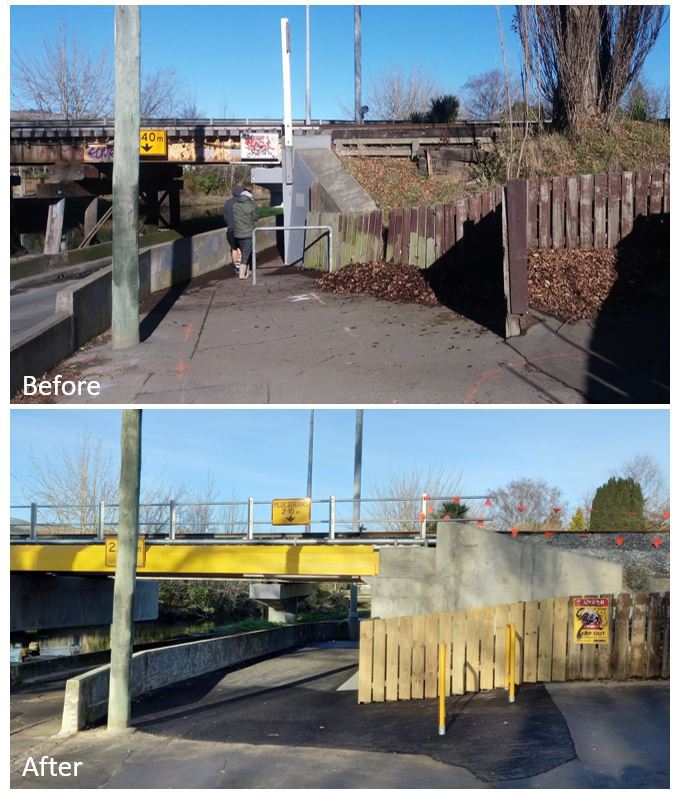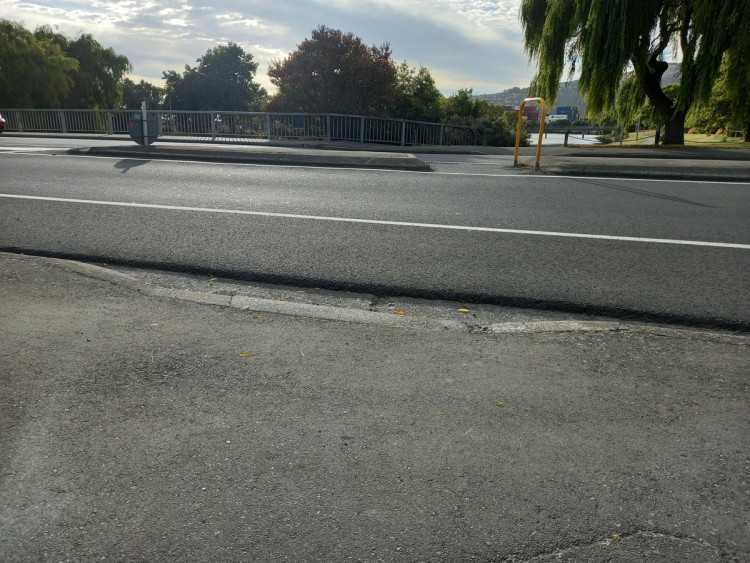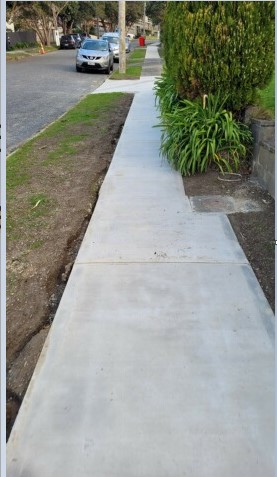Opportunities to save future costs by removing redundant infrastructure
Maintenance inspections can be used to identify any infrastructure that is unnecessary or redundant. For example, if there are signs that are no longer serving their intended purpose, they can be removed instead of being replaced. In some cases, there might be infrastructure that could be converted to greenspace (such as large kerb buildouts or unnecessary road space), which may save on maintenance costs depending on what it is used for, and the type of planting introduced.
Opportunities to improve pedestrian infrastructure in conjunction with maintenance
When combined with other upgrades and depending on the nature and extent of works, maintenance can be used to progressively upgrade pedestrian infrastructure so that it meets current technical requirements and best practice, and, where possible, it meets RCA’s aspirational criteria. As an example, the image below shows the narrow footpath width before a rail bridge was replaced and the wider footpath after the replacement.

A rail bridge replacement offered the opportunity to widen a footpath, Richardson Terrace, Christchurch (Photo: Jeanette Ward).
Some factors to consider when undertaking asset renewals are outlined below. These may not have been considered when the pedestrian infrastructure was originally installed. They include improvements for access for walking, and safety improvements for all road users, such as (but not limited to):
- Footpath renewals/resurfacing may offer opportunities to increase the footpath to align with current standards
- Footpath renewals/resurfacing may offer opportunities to clear vegetation from berm areas that are reducing the footpath width (see example below where a path width was inappropriately reduced to below standard to retain berm planting)
- Provide missing footpath connections
- Suitable surface for all devices likely to legally be using the path, e.g., wheelchairs, mobility scooters, micro mobility devices.
- Smooth, step-free transitions to street crossings, e.g. kerb ramps that are damaged, missing or misaligned should be part of the maintenance programme.
- Adequate signage and wayfinding, including locating signage such that it does not compromise the path quality or pedestrian experience
- Ensuring that trees and other vegetation provides shade and amenity, without degrading the walking experience, through leaf fall, or by reducing visibility between pedestrians and others using the street or by reducing the effective width for walking.
- Resurfacing of zebra crossings should apply current specifications, for example widening the zebra crossing bar marking widths or relocating any areas of red coloured surfacing from under the crossing bar markings
- Whenever a roadway is resurfaced, crossing points must continue to comply with the latest road marking requirements and design best practice. This will avoid problems such as:
- an upstand or ‘lip’ being created between the gutter and the roadway, creating problems for the mobility impaired using kerb ramps (see the image below for an example of where an asphalt overlay has created a tripping hazard at a kerb cutdown, it will also be difficult for wheeled devices to cross the street.
- an increase in the gradient created for pedestrians as a result of the roadway crossfall becoming more severe.
- perpetuating incorrect installation or layout of tactile ground surface indicators.
For the above reasons it is important to consider maintenance of streets in a holistic context, including with consideration of surrounding land use, to get the best return on investment for everyone.

Asphalt overlay that has created a high lip at the kerb cut down point (Photo: Jeanette Ward).
A path width has been inappropriately reduced to below standard to retain berm planting (Photo: Erik Teekman)
For details on path widths, pedestrian characteristics, kerb ramp’s design, wayfinding and zebra crossing’s design elements, see the following sections of this guidance:
PNG: Footpath width
PNG: Pedestrian characteristics
PNG: Kerb ramp design
PNG: Wayfinding
PNG: Zebra crossings
See Traffic Control Devices Manual for latest road markings:
Part 4: Traffic control devices for general use – at intersections
Part 5: Traffic control devices for general use – between intersections


